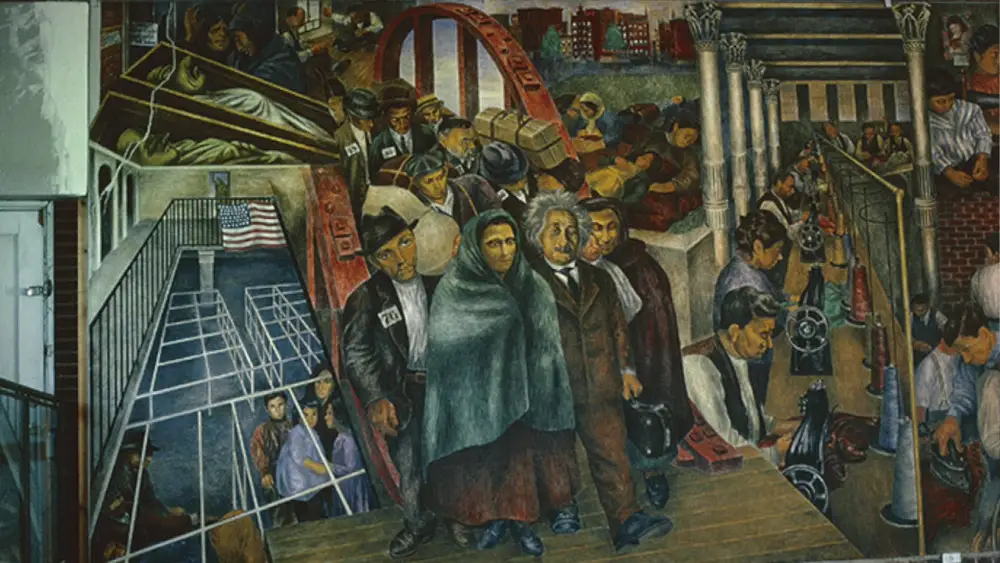Ben Shahn in Roosevelt Elementary School
On the wall of the entry lobby to the Roosevelt Elementary School, spread 45 feet across the wall, and rising a magnificent 12 feet, is Ben Shahn’s story of the immigration of Eastern Europeans to the United States in the early part of the 20th century. The story, a fresco the social realist painted when commissioned to do so by the federal Farm Security Administration, tells in stark realism the struggle Eastern European Jews faced, the battles they had to fight and the settlement they designed that, working together, created a community and made a new, happier life possible in a new homeland. First called the Jersey Homesteads, the town, carved out of Millstone in Western Monmouth County, was one of 99 communities created as part of President Franklin Roosevelt’s New Deal initiative. In appreciation of the community, the only one of the 99 to be planned as an agro-industrial cooperative for urban Jewish garment workers in New York, the residents changed the name to Roosevelt after the President’s death in 1945. Ben Shahn had never been to Roosevelt before he accepted the job in 1936. An immigrant from Lithuania, Shahn was eight when his mother brought him and his siblings here in 1906 to re-unite with his father, who had fled exile from the Russian Empire country and managed to get to America. The family lived in New York, and Shahn was apprenticed to a lithographer during his teen years, entering New York University when he was 19, and later studying with the National Academy of Design. He traveled extensively to Europe and Africa both painting and studying with other masters and staging his first one-man show in New York in 1929. In creating the mural, whose purpose was to explain visually the foundation of the Jersey Homesteads, Shahn used the medium of fresco, painting done on moist plaster with color pigments dissolved in water, he had learned from Mexican artist Diego Rivera. Rivera was also a social realist and influenced Shahn’s political views which were often displayed in the numerous works he created, either for specific commissions or for sale. Art historians also believe the Roosevelt mural not only tells the story of the Monmouth County community, but is the artist’s own Haggadah, or telling, the Jewish tradition to read at the Jewish feast of Seder as a fulfillment of the ancient law for every Jew to tell his son the story of liberation from Egyptian slaveryreminiscent of the story of Haggadah, the Jewish sacred text which is the history of Jewish slavery, deliverance and redemption. Like the Haggadah, Shahn’s 45 by 12-foot mural in Roosevelt is created in three main specific areas. The first panel tells the story in paint of the arrival of Jewish immigrants from Germany and Eastern Europe to America and their struggles as they , the second, the immigrants’ work in sweatshops in New York their crowded tenements, and their involvement in the union movement. The third panel shows success, the planning and development of their new hometown, complete with factory, farms, and the people who made it all happen. Shahn included in his mural likenesses of people he knew or were involved in the immigration of the 1920s and 1930s.His own mother is shown as an immigrant arriving at Ellis Island in the first panel, together with Albert Einstein, a friend of Shahn’s, and Raphael Soyer,, well known Russian-born activist rallying against the fate of women in New York factories and sweatshops. In the second panel, a crowd is depicted gathered in front of the Triangle Shirt Waist Factory, the factory where reportedly doors were locked to prevent union leaders from talking to the female workers and the women were burned to death at their workbenches. The panel shows a union leader addressing the crowd, and a placard with words by union leader John L Lewis. The person depicted appears to be a composite of Lewis and David Dubinsky, the leader who headed the International Ladies Garment Workers Union. Local residents of the Monmouth County community also appear in the crowd. The third panel depicts some of the men who were responsible for establishing the Jersey Homesteads, and features journalist Heywood Broun, New Deal advisor Rexford Guy Tugwell, New York Senator Robert Wagner, who was the primary author of the National Labor Relations Act., and Sidney Hillman, the founder of the American Labor Party the year before the painting was completed. Also shown in the painting, though only from the back, is Alfred Kastner, the innovative architect who designed the town with their unique geometric forms, flat roofs homes, communal areas and lush green land surrounding the community. Also shown is John Brophy the first National Director of the CIO. Shahn and his wife did not leave Roosevelt once his painting was complete. The couple had found hospitality, friendship, and a rural environment in which they felt comfortable and decided to stay, at least for a short time. It gave the artist the opportunity to help out the town one more time. Despite the efforts of the residents, an infusion of money from the government and supporters of the community style of life, Roosevelt began to fail, morale fell as original settlers lost their investment, and disagreement among local governing body members impacted grants and loans from the government. But Shahn’s presence brought an influx of artists and writers, and the community became known as a colony for culture and the arts. New residents also include pianists, opera singers and writers. Shahn died in 1969 and is buried at Roosevelt Cemetery. His painting remains vibrant, vivid, and a stark reminder of what an earlier generation endured and overcame to start life in a new country.

